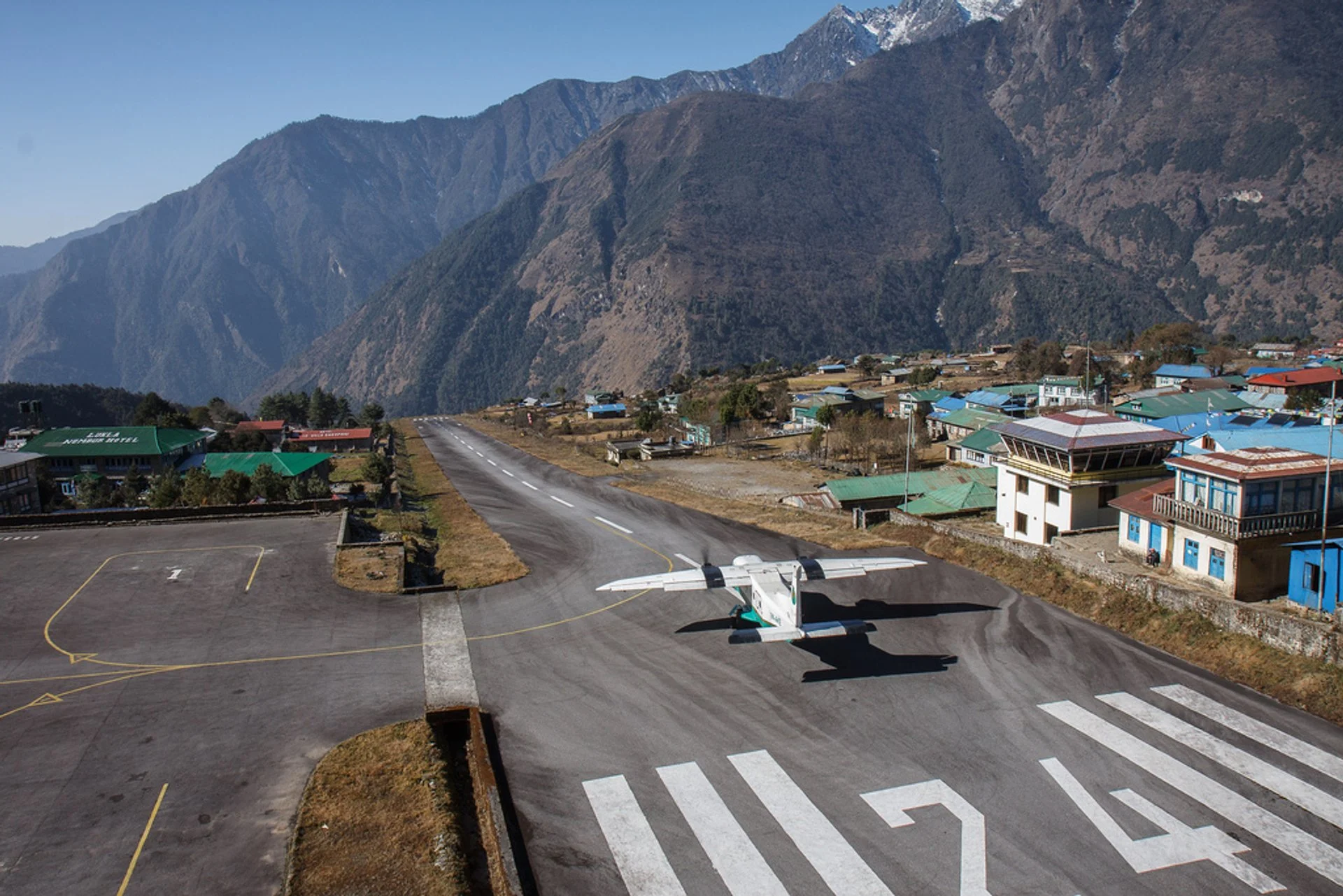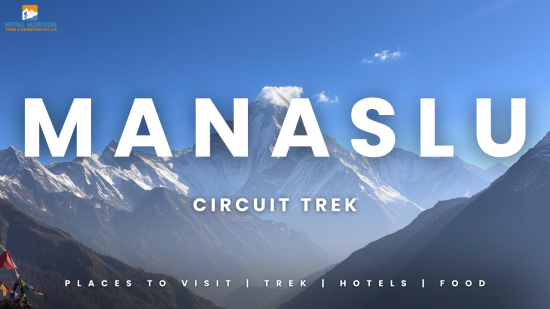Lukla To Everest Base Camp Trekking Highlight
17th October 2022
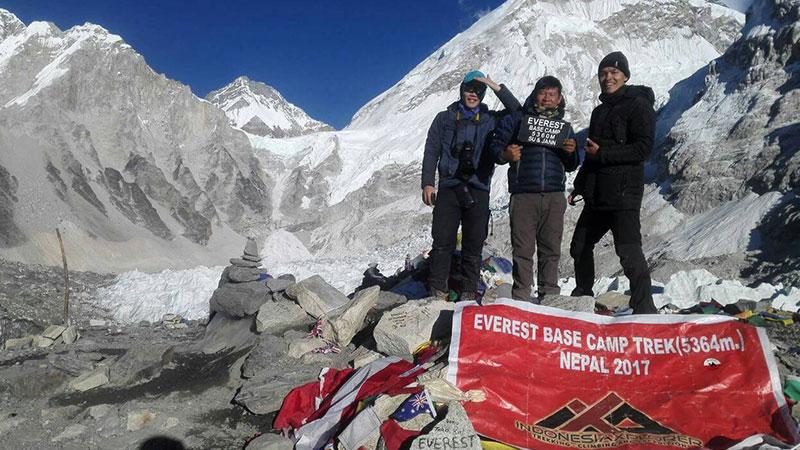
Tenzing Hillary Airport was founded in the middle of the 1960s (1964) under Sir Edmund Hillary's direction. Tenzing-Hillary Airport's runway measures 527 meters (1,729 feet) by 30 meters (98 feet) and has an 11.7% gradient. The airport is 9,334 feet above sea level (2,845 m). Because there is no road to this area, it is utilized to transport people and most of the building supplies and freight to Lukla and other towns and villages in the Everest region. Using a single runway is required for both arriving and leaving aircraft. Due to the challenges of successfully landing at the airport, the Civil Aviation Authority of Nepal has high standards, and only experienced pilots with at least 100 short-takeoff-and-landing (STOL) missions under their belts, over a years of STOL experience in Nepal, and ten missions into Lukla with a certified instructor pilot are permitted to land at the airport. It serves as the beginning point for hikes to Mount Everest Base Camp. High winds, cloud cover, and fluctuating visibility frequently result in flight delays or airport closures. The Nepali armed police or civil police patrol the airport constantly for security reasons as it is enclosed by a chain-link fence.
Amazing facts about Lukla Airport
• Tenzing-Hillary Airport was given the name Lukla Airport in 2008 to recognize Sir Edmund Hillary and Tenzing Norgay, the first two people to climb Mount Everest and lead the initiative to build the airport.
• The only other means of transportation from Kathmandu to Lukla are via road and a nearly one-week (5-day) long hike from Jiri to Lukla.
• The airport was built with the direct participation of the Sherpa inhabitants of Lukla and the surrounding area.
• It is regarded as one of the most dangerous airports in the world.
• It is situated 9,334 feet above sea level (2,845 m).
• There are issues with plane takeoffs and landings due to the runway's small length of 527 meters.
• On a flight to Lukla, luggage weighing up to 15 kg is permitted.
• When traveling from Kathmandu to Lukla on the left side of the aircraft and back to Kathmandu on the right side, you are rewarded with breathtaking mountain vistas.
• Starting with the north, the runway is used for landing, and beginning with the south, it is used for takeoff.
• Additionally, pedestrians can cross the runway on any side by using it.
• At Lukla Airport, more than 50 flights are completed each day.
• There is no air navigation or radar system; only radio communication is used for landing and takeoff.
Is Lukla a dangerous airport?
Lukla is referred to as a dangerous airport in the world. The geography of the airport's location, together with elements like a relatively short runway and scarce energy, makes it one of the most hazardous airports in the world. There are no go-around procedures for this airport because of the landscape and the small chance of a safe go-around for a missed approach. A 30-minute flight will get you from Kathmandu to Lukla. However, the former is 2,859 meters above sea level, whereas the latter is 1,400 meters. In 2019, nearly 130,000 people used the runway at the remote mountain town community. Most people travel to the Himalayas for trekking adventures.
High-altitude air is thinner, which makes it harder for engines to produce thrust. The longer the runway, the better because of the decreased resistance, which also makes it more difficult to slow the plane down.
However, the runway at Lukla Airport is not particularly friendly to that aim. It is only 527 meters long, made of paved asphalt, and rests on a small mountain ledge. It would take a skilled track and field athlete roughly 60
seconds to complete, with the altitude adding a few extra seconds. Due to its short length, it features a 12% upward slope to help planes slow down when they land.
Only helicopters and light, fixed-wing, short-takeoff and landing aircraft like the De Havilland Canada DHC-6 Twin Otter, Dornier 228, L-410 Turbolet, and Pilatus PC-6 Turbo Porter are permitted to use the airport's prepared asphalt runway. The runway has a gradient of 11.7% and measures 527 m (1,729 ft), and 30 m (98 ft). The airport is 9,334 feet above sea level (2,845 m). A chain-link fence surrounds Lukla Airport, which is constantly patrolled for security by either the Nepali armed police or civil police.
In excellent weather, there are regular flights between Lukla and Kathmandu during the day. Even though it is only a short flight, it frequently rains in Lukla while it is sunny in Kathmandu. Since there is no road to this area, the airport is used for passenger flights as well as to move the majority of building supplies and cargo to Lukla and other towns and villages to the north of Lukla.
Actually, one of Nepal's busiest airports is Lukla Airport. It will be challenging for airport workers to manage the flights when the airport has more than 60 planes per day during the busiest months. The Lukla airport is described as a dangerous airport by a trio of primary factors-small airport, poor weather, and crowds at the airport. According to the history of the death rate at the Lukla airport, there is actually one fatality for every ten thousand passengers annually.
However, technology has greatly aided us in keeping our lives safe nowadays, and aircraft firms have excellent safety records despite using risky flight paths and having a perilous runway at Lukla. If the weather does not cooperate well enough to operate safe flights, they postpone or cancel the flights. The remote Lukla Airport now has 90 standard chassis AV-426 solar aviation lights thanks to Mahavir Shree International, an Avlite Systems Nepal partner. The adaptable light was ordered in a variety of arrangements.
For a variety of aircraft applications, the AV-426 is a reliable, fully self-contained LED solar aviation light. These include the runway threshold, helipad, permanent approach, and tactical airfield lighting. The AV-426 is equipped with RF control, so it can be operated from a tower or from the ground without the need for pricey trenching or wiring. The AV-426 has cutting-edge solar technology. Active maximum power point tracking (MPPT), which maximizes the power harvested from solar panels, is one example of this. With the class-leading economy and operational runtime, the AV-426's upgraded optics improve performance. Avlite has contributed to the safety of Lukla Airport by providing high-quality lighting that enables pilots to fly safely near popular tourist destinations. The aviation lights from Avlite are lightweight, strong, and use little electricity. The AV-426, which has RF operation, is part of the solution and makes it simple to turn the system on. It is the best option for this particular set of requirements.
Flying to Lukla
The Everest region offers some of the most breathtaking trekking in the world and getting there is a journey in and of itself. Almost all treks start with a flight from Kathmandu to Lukla's Tenzing-Hillary airport, a small airfield with a single runway located high in the Himalayas. For many treks in the area, it is the only way to get to Everest Base Camp. At a height of 2,860 meters (9400 feet), Lukla is a popular destination for trekking and shipping all year long. This airport receives almost every trekker and piece of equipment, and traffic has been steadily increasing over the years.
The aircraft only takes about 30 to 45 minutes to travel from Kathmandu to Lukla (only 12 minutes from Ramechhap). As you fly over one solitary mountain valley after another, observing the terraced scenery of Nepal's interconnecting mountain ranges pass below you, you will be able to personally witness why overland travel in Nepal can be so challenging.
Once you book your trek, send your passport information to the trekking company as soon as possible so they can book your Lukla flight earlier. Spring and autumn are the best seasons for Lukla flights. As long as the weather is clear and stable, the Lukla flight during spring and autumn is less risky. Try to get an early flight as it reduces the chances of delayed itineraries and increases your safety.
The approach to Lukla is extremely difficult since the landing strip there is narrow and stretches to the edge of a huge cliff face. Only extremely tiny aircraft and helicopters may access the airport because there is only one feasible approach path through the windy valley it overlooks. Its location and height make it susceptible to sudden changes in the weather and visibility. This makes it challenging to plan or anticipate the flight. Airlines don't gamble with the weather; if conditions have altered since takeoff, they will return an aircraft to Kathmandu at any point in the voyage rather than run the possibility of an unsafe landing.
Lukla airplane delays are fairly frequent. These can occur at any time of the year, but the monsoon season increases their likelihood (late May to early September). Your travel agency member will reschedule you on the following flight if your flight is delayed. It is very impossible to estimate when this will be because things can change so quickly. It might be right after your scheduled departure or even a few days later. Although it can be somewhat frustrating, this is just a necessary step on the way to the Everest region. To give yourself some wiggle room in case of delays, we strongly advise that you extend your trip by at least one or two days.
With a bit more flexibility in their approach to Lukla, helicopters are frequently able to complete the flight in conditions that would prevent a small plane from taking off. Although it can be costly and is not always a guarantee of an on-time departure, it is occasionally possible to switch your flight itinerary to a helicopter. When you return to Kathmandu, we'll help you make arrangements with the helicopter business and reimburse you for the cost of your plane ticket if you choose to take this path. To make sure that our visitors can always go as quickly as possible, we collaborate closely with both helicopter and airline businesses.
Weather at Lukla airport
It is a known fact that the weather in high elevations is erratic. Rain, wind, sun, and storms can all occur on the same day, causing a continual fluctuation in the weather. However, due to its high mountainous location, the weather at Lukla Airport rapidly deteriorates. Additionally, the local weather has an impact on how well the airport is able to function. As the climate, weather, and temperature are more constant than they are on other days, flights to Lukla start early, at 6 in the morning. The day begins with a buildup of clouds. Flights are conducted using Visual Flight Rules and must go across steep mountains in less than 40 minutes (VFR).
While rain clouds are active throughout the monsoon, wind and thunderstorms are frequent in the afternoons of spring. Winters in Lukla offer better vision, but sometimes flights from Kathmandu are affected by the fog there. Additionally, if the weather deteriorates, Lukla Airport may close in a matter of minutes, which might delay or cancel flights. Before starting your trek, check the weather in Lukla so there is no delay for your trip.
The weather in Lukla affects whether flights are canceled, delayed, or postponed. Thus, when the weather is good, Lukla''s flights run early in the morning. The flights to Lukla are occasionally continually delayed for weeks. The weather in Lukla is constantly changeable. Therefore, if you intend to hike up Mount Everest, it is advised that you have one and a half back up days.
Lukla flight cancellation
The flights between Kathmandu, Lukla, and Kathmandu may occasionally be delayed for a few minutes to a few hours due to adverse and unforeseen weather conditions. The beginning and end of the rainy season, as well as when there is a lot of aviation activity.
The Lukla airport's runway is only a short distance long, and it ends with a cliff that faces forward. Only tiny aircraft like Dorniers, twin Otters, or helicopters may fly because there is only one runway with a short area. In Lukla, the weather and visibility can quickly change. The normal flight schedule is challenging under these circumstances. Even if the flight has already departed from Kathmandu towards Lukla, it occasionally needs to return to Kathmandu for various reasons. Even after the flight has left Kathmandu for Lukla, it occasionally has to return due to the clouds lifting at the airport in Lukla. It's common practice to postpone battles until Lukla. Any time of the year, but particularly at the start and end of the monsoon season, it could occur (Late May and begging September).
One of the most hazardous airports in the world is Lukla Airport. The short runway, the ridge at the end of the runway, and peculiar weather are to blame. However, during the busiest trekking and climbing season, 20 to 30 aircraft land each day. Each year, more than 30,000 hikers enter through this airport. Although it is acknowledged as being riskier than other typical commercial airports, it is nonetheless rather secure.
Aviation officials, airline firms, and pilots have been more rigid and cautious about the appropriate weather and flight condition following a severe crash in October 2008 that involved people. The passengers now have excellent safety thanks to this. However, given the situation, flying to Lukla can still be anxiety. To save our customers any suffering, we make every effort to get them on the first aircraft to Lukla. In order to do this, the flight must be scheduled a few months before the date of your arrival in Kathmandu. When you plan a trip with us and email your passport copy along with the booking fee, we instantly reserve your seat on the flight to Lukla.
Best time for Lukla Airport
The tundra climate supports Lukla. The region has a stylish adaptation to the temperate climate. With high precipitation rates, summers are rainy. Summer here begins in late June and lasts until the end of September because Lukla is in the northern hemisphere. Because of its chilly environment, Lukla experiences snow virtually all year long. With an average high temperature of -3.9°C and an average low temperature of -14.7°C, January is the coldest month. The climate in Lukla Village is consistently chilly and muggy. But there are also sunny days there. Early in the morning, the sky is typically clear. But in the late afternoon, the fog obscures everything. Let's read in the description the weather conditions of Lukla in different seasons.
Spring season (February-May)
Springtime lows range from (27.1°C) to (17.4°C), with warmer weather later in the season. Once more, rain is frequent in the later months, with 5 to 9 days of considerable precipitation every month. But because of the clear skies, it is possible to see the mountains clearly. The mesmerizing clouds give the impression that you are on top of the world as they glide across the brilliant blue sky. Observe the various bird species that call the beautiful oak, pine, and rhododendron trees home. A different atmosphere is created by the river's trickling passage through the picturesque meadow.
Summer (June-August )
Visitors will not enjoy the hot temperatures throughout the middle of the year. The trails are constantly getting slicker. Thus, this is the season that is least busy. If you go to Lukla in the summer, there won't be many trekkers there, so hotels and other amenities will be easy to come by. Even though it rains a lot from June to August, some tourists nevertheless choose these months. It's because it provides stunning vistas of the hills and mountains, as well as freshly-washed trees that are bright and green.
Autumn (September-November)
The temperature in the fall varies from 79.5°F (26.4°C) to 64.2°F (17.9°C). The climate begins to settle, and the days are sunny. The days can grow warm when it's sunny, even when the nights get chilly. In September, there were several canceled flights from Lukla. However, flights begin running continuously in October. Although there are more opportunities to fly in October, there is still a potential for cancellations throughout some of the month.
Winter (December- February)
Warm-weather enthusiasts may find it challenging because of the cool temperature. Average precipitation and snowfall totals are modest (0–1 time per month).
The number of tourists is lower than in other months due to the chilly weather. However, the scenery is clearly visible and unobstructed. In Lukla, lodging and food are less expensive than they are during other times of the year.
Regarding Lukla flights, there are generally few delays or cancellations during these months. The majority of trekkers visit the area in October and November when the weather is fairly clear. Here's a little-known fact: December is the least popular month for trekking. Low trekker traffic, excellent visibility, and efficient Lukla flight operations are all present.
Lukla to Everst base camp trek
Lukla is a very famous and important airport because it is the airport from where every popular trek starts, including the Everest base camp trek, Annapurna base camp trek, Annapurna circuit trek, and so on. Flying from Kathmandu to Lukla and then trekking to EBC is one of the simplest, quickest, and most popular routes. Few trekkers choose the alternate path to get to EBC because the trip from Kathmandu to Lukla is both pricey and exciting.
You can trek to the foothills of Mount Everest, the tallest mountain in the world. Everest Base Camp, which is located at 5,364 meters, provides a close-up perspective of some of the highest peaks on the planet.
The traditional and most popular trekking route to the Everest region has been from Lukla to Everest Base Camp since Lukla Airport was created in 1964. The only way to reach Everest used to be from Jiri; today, the famous Everest Base Camp Trail begins in Jiri and leads to Everest Base Camp. Your trek to Everest Base Camp (EBC Trek) will be filled with incredible experiences and memories. You may learn about the vibrant Sherpa culture and take in Sagarmatha National Park's astonishing biodiversity. Even without the surrounding population, Mount Everest is a stunning sight. The total experience is amazing, and the views are breathtaking. Even without the surrounding population, Mount Everest is a stunning sight. The total experience is amazing, and the views are breathtaking.
Highlight of Lukla to Everest Base Camp
• This amazing journey to Everest Base Camp begins with an exhilarating mountain ride over the vast Himalayan range as you fly from Kathmandu to Lukla.
• Discover the Sherpa people's rich cultural heritage and immerse yourself in their way of life.
• At this elevation in Sagarmatha National Park, the biodiversity is astonishing.
• Even just getting to the foot of Mount Everest, which stands at an elevation of 8845 meters, is an accomplishment.
• Ancient monasteries are a reflection of the depth of art, architecture, and history.
• The Everest Base Camp journey has the greatest views in the world, with majestic peaks always in view. The landscape is made more beautiful by the green valleys and thick forest.
• Observe the sunrise from the summit of Kala Patthar. You'll be awestruck by the magnificence during the golden hour.
• A chance to see Khumbu Glacier, which is the tallest glacier in the world.
Recent From Blogs
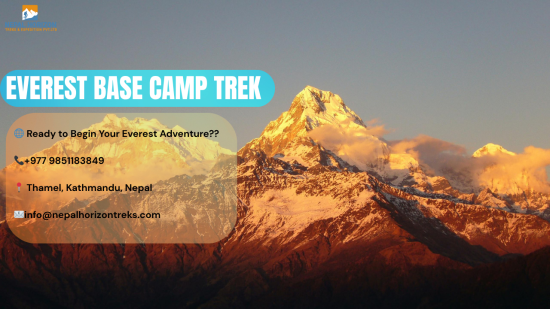
28th October 2025
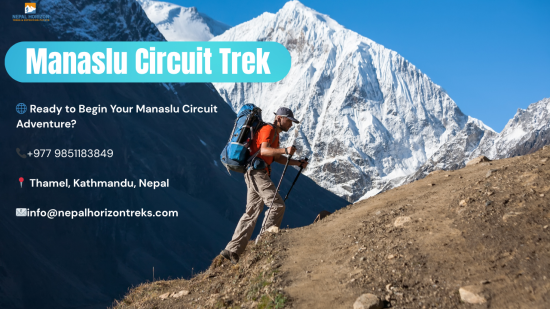
25th October 2025
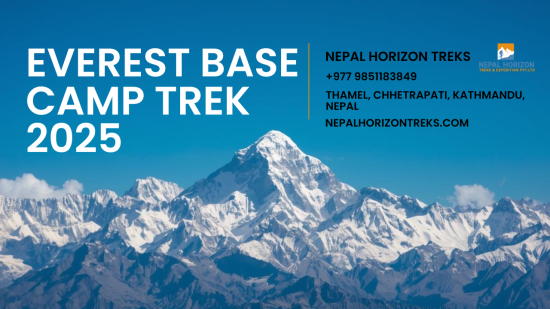
24th October 2025
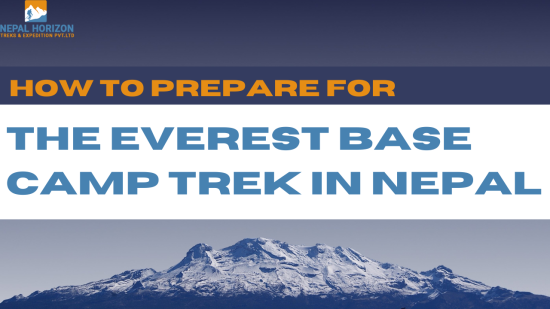
18th October 2025
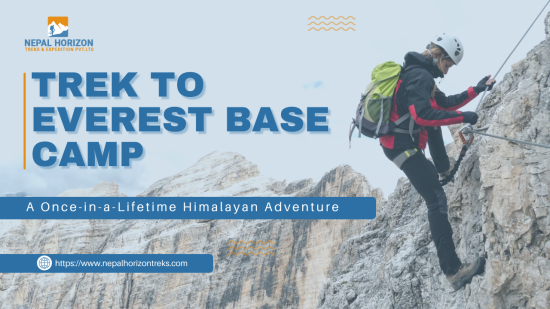
14th October 2025

12th October 2025

10th October 2025

7th October 2025


